-
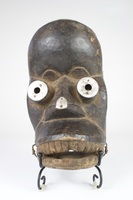
Carved wooden mask, with hinging jaw and round iron forms to represent eyes. The forehead and the upper jaw protrude, to create exaggerated features. The Dan mask may be associated with forest spirits, manifesting their powers. This mask can be grouped into the 11 major types of figures used to represent varying social topics such as education, politics and entertainment.
-
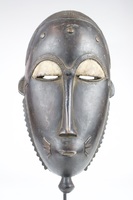
The Baule mask is carved of wood with a dark patina and kaolin on the rounded eyelids. The face is smooth and narrow, with a large forehead. The nose is elongated, met by a small mouth close to the bottom of the chin. A small false beard is centered on the end of the chin. Atop the head is a stylized coiffure marked by delicately incised lines. Three round protrusions line the forehead, thin patterns fill the eyebrows, and lines extend outward from the corners of the mouth; all potentially representing scarification patterns. Wrapping around the face are small triangular forms, a common characteristic of Baule face masks.
-
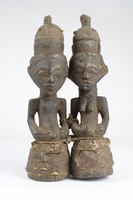
The male and female twin figures are joined by thin rope that has been tied at both the waist and crook in the arm. The figures have recognizable characteristics of Kusu art. The patterning around the top of the forehead and chin are common, along with the closed eyes, rounded lower abdomen, and style of the arms. The figures may have been created prior to the birth of twins as a form of good luck, or created after their death in order to appease the spirits of the deceased.
-

The small, standing colonial figure represents the influence of the European settlers in the Baule area in the early 20th century. The figure is painted to reflect the aesthetics of European attire, such as the large white hat. It was common practice for small standing figures to be made as "spirit lovers", or an ideal vision of a spouse. It is possible that the small colonial figure was created as a spirit lover, that reflected the new societal ideals introduced by the Europeans.
-

Small, thin female standing figure with minimalist details. Breasts, necklace, and incised lines around the waist and thighs to resemble clothing. The arms are kept close to the body, with the hands resting above the small, circular navel. The legs are stout and thin, spread wider than the shoulders, creating a pyramidal composition with the head at the top. The eyes are large for the face and the mouth is slightly open. A stylized coiffure has been carved on the head, expanding upwards but cut horizontally at the top. This figure may be a representation of the Blolo Bla, a spouse from the spirit world.
-
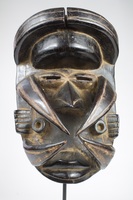
The Gere mask is carved of wood with a thick, dark patina. The forehead bulges forward, with a thin central division. The eyes are formed by narrow horizontal openings under the forehead. The nose and mouth extend forward with sharp angles to compliment the four horns that round inward to the center of the mask. on either side of the face, under the nose, are small holes alongside horizontally incised lines.
-
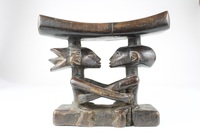
The Luba wooden headrest is decorated with two seated figures in an embrace with stylistic coiffures. The headrest was used by high-ranking dignitaries for comfort when sleeping and for the protection of elaborate hairstyles.
-

The carved wooden stool has clear characteristics of the Luba style, such as the facial features and seated position. The figure is female with a round abdomen and pronounced navel, decorated with scarification patterns. The base of the stool and round seat supported by the figures arms are decorated with a wrapping pattern depicting cowrie shells. The stool has a functional construction however it was most likely used for decorative reasons, or as a metaphorical seat of kingship for the Luba leadership.
-
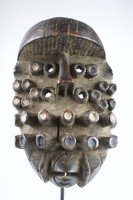
The large wooden Bete mask is coated in a dark, glossy patina with white kaolin and a blue pigment in the centers of the cylindrical protrusions across the face. Four of the central circles have been hollowed out, for the masker to see and breathe out of. A large overhanging, rounded forehead juts over the eyes and nose. The mouth is tucked underneath the lowermost row of cylindrical forms, and is defined by a thick incision to separate the top and bottom lip. The Bete Gle or Gre mask was used in ceremonies to represent the hostile forest spirits, establishing the maskers as protectors of the spiritual forces.
-
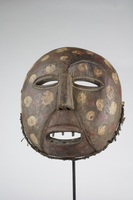
The carved wooden mask is detailed with a polychromatic pattern of dots, potentially representing the bodily decorations applied during ritual practices. The overall form is round and the mask has a low relief with minimalistic facial features. Teeth, formed by small pieces of wood, line the wide mouth. The eyes are narrow and hollow with thin incised lines above them marking the brow.
-
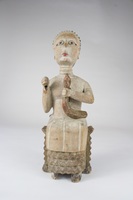
A seated wooden female figure, grasping a snake in one hand, and an open space within the clenched fist of the other. The figure has naturalistic, yet exaggerated features and a stylized coiffure. The figure may represent royalty, potentially depicting a Queen Mother, as it is seated in a highly detailed chair and covered in a chalk-like pigment. On festival days, Akan royalty would cover their skin in white powders to show their reverence and devotion.
-
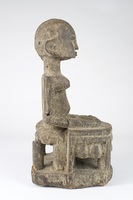
Two seated figures playing the balafon, an instrument that was relatively uncommon in Dogon communities. The Balafon was used for ceremonial purposes. The sculpture itself could be in reference to two specific characters from the epic narratives of the formation of the Mali empire, Sologon and Bala, ca. 1230. Twin figures are seated in front of a xylophone-type instrument, with mallets in each hand.
-
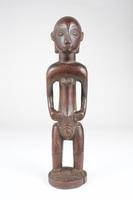
Standing, wooden female figure with clear characteristics of the Luba style, such as the highly polished wooden surface, broad and round forehead, and thinly inceside facial features. The figure may be a standing Mboko, or diviner. The Mboko were used during ceremonies regarding the induction of a new chief. Natural materials of medicinal value would be packed within the figure, as to the Luba, women were believed to have a strong connection to the spirit world.
-
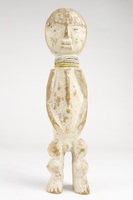
Small standing figure carved of wood, with remnants of white kaolin. The figure has been sculpted with a vertical emphasis, as the arms remain attached to the sides of narrow hips. Beads wrap tightly around the neck, dividing the large head from the body. Several iron nails line the forehead of the figure.
-
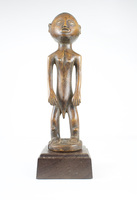
The small male standing figure is carved of wood with remnants of a dark patina on the surface. The figure has a large, round head with circular eyes and an ovular open mouth. The body is thin, with a gap between the arms and torso on either side. Pectorals and the navel are marked with small circular protrusions of low relief. Male genitalia can be seen under the low belly. The knees appear to be pronounced, as they extend forward from the legs.
-
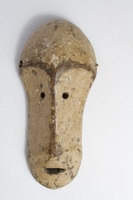
Small Lega mask with recognizable characteristics such as the heart shape of the brow bone and long, slender nose. The Lega mask was used by in initiation ceremonies, and was rarely worn on the face, but rather used as decoration on the body or held in one's hand.
-
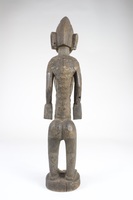
The carved wooden female figure has clear characteristics of the Bambara style, such as the coiffure, head shape and facial features. The face is concave, with small pinholes for eyes, and a long, narrow centered nose. The large ears have pierced holes, potentially adorned with jewelry during use. The shoulders and abdomen are decorated with scarification patterns that can be seen on other female figures from the Bambara culture.
-

Standing female figure carved of wood with few details painted in black. The hairstyle is defined by incised lines on the top of the head that angle downwards toward the back of the neck. The face is flat, with features of a low relief, and small ears on either side of the head. The body is long with stocky legs, with no sharp edges but rather very rounded forms.
-
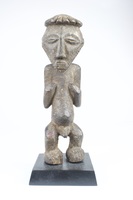
The small male ancestor figure has clear characteristic of the Hemba style, such as the long face and torso, and stylized patterning around the chin. The coiffure atop the head has radiating incised lines stemming from the center to mimic strand of hair. The eyes are closed, yet the mouth is open, forming a rectangular shape with small teeth. Arms rest high on the chest, and the legs are thick and stocky.
-
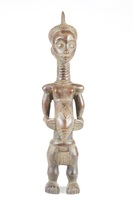
The carved wooden female ancestor or power figure is highly decorated with scarification patterns and incised lines marking the collar necklace and loin cloth. The figure may be a representation of the "Mupaki wa manga" power figure, protecting from and controlling otherworldly forces.
-
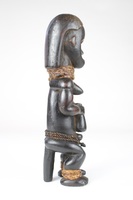
A seated wooden figure holding a small vessel with arms and legs wrapped in rope.The Byeri, or reliquary guardian figure, has supernatural properties that ward off evil spirits and bring good fortune. The figure has a calm expression yet is carved to depict strength through the detail of musculature.
-
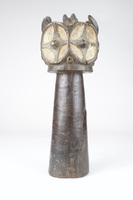
The Bembe Janus head symbolizes the Alunga mask. The Janus head has noticeable characteristics such as the double faced composition with large conical eyes. The eyes protrude from cross shapes of black, contrasting the white kaolin circles beneath them. Alunga is described as a spirit or force that can affect the living, specifically connected to hunting and the forest.
-
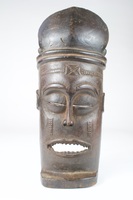
The wooden Pwo mask represents a female archetype, an ancestral personage who encourages fertility. The vertical lines descending from the narrow eyes resemble tears, while the symbol in the center of the forehead is believed to be a cosmogram. The Pwo masks were often highly decorated, with raffia and other natural materials.
-
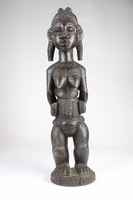
Wooden standing female figure with child on their backside. The figure has a unique, detailed coiffure and scarification patterns on her face, chest and torso. Images of women with children depict a woman's completion of adult responsibilities.
-
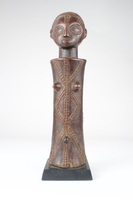
Wooden Mpundu female figure consisting of an elongated, round torso and head. The head has the detailing of a stylistic coiffure, marked by incised lines in the wood. The torso is decorated with scarification patterns along the vertical axis surrounding the breasts and navel.
























